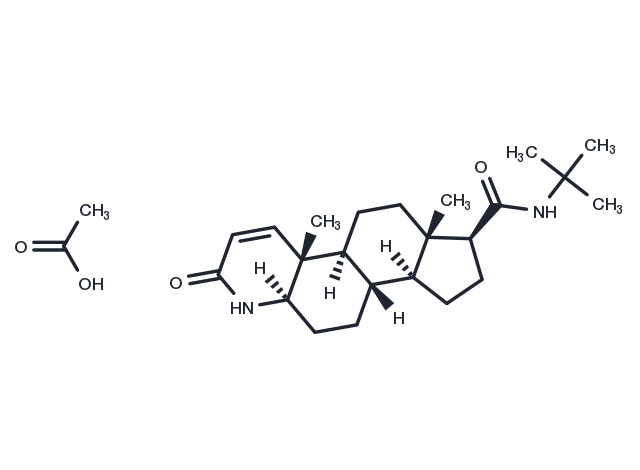Powder: -20°C for 3 years | In solvent: -80°C for 1 year


Finasteride (MK-906) acetate is a potent and competitive 5α-reductase inhibitor, with an IC 50 of 4.2 nM for type II 5α-reductase. The affinity of Finasteride acetate for type II 5α-reductase enzyme was approximately 100-fold higher than that for the type I enzyme. Finasteride acetate can be used for the research of benign prostatic hyperplasia (BPH) and androgenic alopecia [1] [2] [3].

| Pack Size | Availability | Price/USD | Quantity |
|---|---|---|---|
| 25 mg | 6-8 weeks | $ 2,140.00 | |
| 50 mg | 6-8 weeks | $ 2,785.00 | |
| 100 mg | 6-8 weeks | $ 3,520.00 |
| Description | Finasteride (MK-906) acetate is a potent and competitive 5α-reductase inhibitor, with an IC 50 of 4.2 nM for type II 5α-reductase. The affinity of Finasteride acetate for type II 5α-reductase enzyme was approximately 100-fold higher than that for the type I enzyme. Finasteride acetate can be used for the research of benign prostatic hyperplasia (BPH) and androgenic alopecia [1] [2] [3]. |
| In vitro | Finasteride, at a concentration of 10 μM over incubation periods of 6 to 24 hours, induces the expression of HO-1 and Nrf2 proteins in PC-3 cells, and also inhibits the conversion of [3 H]testosterone (T) to [3 H]dihydrotestosterone (DHT) in P. crustosum. In cell viability assays involving PC-3, DU-145, and LNCaP cell lines treated with finasteride at 10 μM for durations of 6, 12, and 24 hours, there was a noticeable increase in HO-1 protein expression in a time-dependent manner specifically in PC-3 cells. Additionally, finasteride triggered the expression of Nrf2 protein in DU-145 and PC-3 cells, though not in LNCaP cells. |
| In vivo | Finasteride, administered orally at a dosage of 0.1-0.5 mg/kg once daily for 16 weeks, effectively reduces prostatic size in male dogs aged 2.7-11 years and weighing 10.3-49 kg with spontaneous benign prostatic hyperplasia (BPH), as indicated by a decrease in prostatic diameter (20%), volume (43%), and serum dihydrotestosterone (DHT) concentration (58%). This treatment does not negatively impact semen quality or serum testosterone levels and is free from adverse effects on the animals [3]. |
| Molecular Weight | 432.605 |
| Formula | C25H40N2O4 |
| CAS No. | 222989-99-3 |
Powder: -20°C for 3 years | In solvent: -80°C for 1 year
You can also refer to dose conversion for different animals. More
bottom
Please see Inhibitor Handling Instructions for more frequently ask questions. Topics include: how to prepare stock solutions, how to store products, and cautions on cell-based assays & animal experiments, etc.
Finasteride acetate 222989-99-3 Finasteride Acetate inhibitor inhibit
